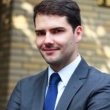This session examines how the sharing of best practice can improve the wind industry's health and safety performance through innovative, proactive research and hands-on experience.
You attended this session?
Learning objectives
- Implementing best practise in safety;
- Managing performance through integrated safety thinking;
- Innovative safety aspects when moving from fixed to floating offshore;
- Setting industrial standards to provide constant safety leadership;
- Safety leadership throughout the industry from management level to operational level.


Presenter

Co-authors:
Pascal Sommer (1) F Erik Schmidt (1)
(1) 8.2 Consulting AG, Hamburg, Germany
Presenter's biography
Biographies are supplied directly by presenters at WindEurope Summit 2016 and are published here uneditedDr. Sommer has been working in the wind industry for 7 years. He is currently a consultant at 8.2 Consulting AG. He studied French and geography and obtained his PhD (Thesis: Onshore vs. Offshore - Industry evolution between radical and incremental innvation) in economic geography in 2015 at the University of Hamburg. During his PhD he worked at Senvion SE as project manager for test site development for offshore prototypes.
Abstract
From fixed offshore to floating offshore – A new challenge for QHSE
Introduction
In the past decade offshore wind has become mature. During the development of the global offshore capacities the industries learning curve has been very steep. This fact does apply for nearly all topics dealing with the transition from onshore to offshore including technical aspects, financial aspects and organizational aspects, especially QHSE. With the emergence of floating offshore the need for adapted QHSE approaches is crucial for a lasting success of floating offshore. The proposed paper investigates the challenges and solutions for QHSE within the new technology of floating offshore wind turbines.
Approach
The requirements on Quality Assurance (QA) from the “main offshore guidelines” in relation to HSE and cost reduction will be analyzed. We will outline how QA can minimize risks with regard to HSE. In addition anticipated cost reduction factors, realized by compelling QA and the potential of counteractive measures within the turbine/floater production processes will be shown and clarified using related information. Risks, efforts and possible results will be presented. The proposed paper benefits from the experience 8.2 Consulting gathered during its work for the preparation of the QHSE-Concepts for the upcoming floating offshore pilot projects in France.
Main body of abstract
HSE in the offshore environment is the basis for a safe working culture and zero harm approach. With new technologies and different characteristics of the sites, the environment, new turbine types and new component interactions the demands to HSE are consistently growing. On the other hand, cost reduction and related effects are a major topic in the whole Offshore Wind Industry. The cost reduction effects are highly dependent on several internal and external hurdles. Proper quality assurance minimizes risks and thus addresses HSE as well as need for cost reduction. This is why we speak of QHSE. Quality assurance of components is advised and may especially result in cost reduction. Measures to counteract critical aspects may for example be innovative software solutions for critical processes within the assembly and until the installation of the turbines. Further measures and possible solutions are identified in the project organization especially concerning the interfaces between the involved stakeholders.
Based on the working experience of 8.2 Consulting AG in more than 60% of the German deep water offshore projects, and the involvement in the tender phase for the French floating offshore pilot projects, the QHSE risk factors for floating turbine design, assembly, erection and operation will be analyzed.
We present and analyze:
• A comparison of QHSE aspects floating vs. fixed offshore
• The upcoming demands for floating offshore structures
• Risk reduction for floating offshore during onshore assembly, transport and commissioning
• Advantages of floating Offshore structures regarding HSE in general
• Risk elimination through proper planning, communication and supervision
• Perspectives on safety culture for floating offshore
• Standard setting and good practice for floating offshore
Conclusion
QHSE is one of the crucial aspects for the success and acceptance of floating offshore wind energy. An adaptation of existing concepts is required to adapt to the new conditions (environmental but also regulatory and legislative aspects) that are connected to floating offshore wind. We will present detailed facts, demands and actions connected to floating offshore technologies that are crucial for stringent QHSE management. It will be shown that many of the present offshore HSE concepts are going to be subject to significant optimizations for the difficult environment that is floating offshore.
Learning objectives
The paper to be presented wants to highlight the urgent need of the adaptation of existing QHSE-approaches from fixed offshore to floating offshore as the industry is facing new configurations and operational approaches that require respective QHSE-solutions. Several aspects will be presented, to show, that cost reduction is feasible.







Follow EWEA on: